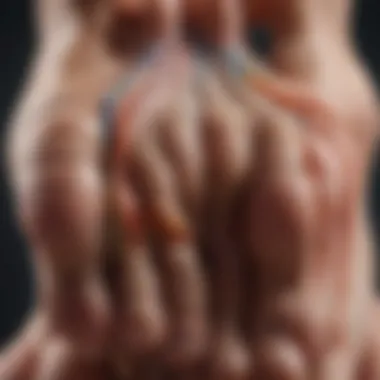Understanding Toe Cramps and Their Implications


Intro
Toe cramps and separation are phenomena that affect many individuals. These issues can disrupt normal function and lead to discomfort. Understanding their causes and remedies is essential for enhancing health and fitness.
Anatomically, the toes play a crucial role in balance and mobility. Cramps often manifest as involuntary spasms of the muscles in the toes, while separation typically refers to a condition where the toes spread apart or do not align properly. Both conditions can arise from various factors.
Key Takeaways
- Understanding the Cause: Specific causes include muscle fatigue, dehydration, electrolyte imbalances, and underlying medical conditions.
- Recognizing Symptoms: Symptoms range from sudden sharp pain to prolonged discomfort, impairing one’s ability to walk or exercise.
- Effective Remedies: Simple remedies like stretching, hydration, and appropriate footwear can mitigate toe cramps. Seeking medical advice is crucial for persistent issues.
- Preventive Strategies: Regular hydration, balanced nutrition, and suitable warm-up exercises can help prevent cramps and separation from occurring.
In-Depth Analysis
A deeper look at toe cramps shows that these spasms can be highly uncomfortable. They often originate due to excessive strain on the muscles—a result of overexertion during physical activity. Scientific studies suggest that dehydration and low levels of certain minerals, like potassium and magnesium, can also contribute to the onset of cramps. Maintaining a balanced diet rich in these nutrients is vital.
Separation of the toes can complicate things further. It may be influenced by conditions like bunions or hammertoes, where the structural integrity of toes is compromised. Identifying the right footwear is essential as improper shoes can exacerbate these conditions.
"Toe cramps may seem minor, but they can signify larger health issues, warranting attention and care."
This highlights the importance of recognizing signs that can inform better personal health management. When cramps or separation occur regularly, consulting a healthcare professional is advisable.
By understanding the intertwined nature of these conditions, individuals can implement worthwhile strategies for prevention and relief. Immediate attention to hydration, nutrition, and proper footwear offers a foundational approach to managing and alleviating toe cramps and separation.
Prelims
Toe cramps and separation are not only discomforting but can also be indicators of underlying health issues. Understanding the implications of these ailments is crucial, especially for health professionals, wellness coaches, nutritionists, and fitness trainers. They must be equipped with knowledge to address concerns related to toe cramps and separation since these conditions can affect mobility and quality of life.
In this article, we will explore the complexities associated with toe cramps and separation. By widening our understanding, we can create effective strategies for prevention and management. Awareness of the symptoms, diagnostic methods, and treatment options will empower individuals to take proactive measures in safeguarding their foot health.
Definition of Toe Cramps
Toe cramps are involuntary muscle contractions that typically involve the muscles in the toes. They can vary in intensity and duration, causing a sudden tightness that may last for merely seconds or for multiple minutes. Often, cramps occur during physical activity but can also manifest while at rest. Although cramps are common and might happen at any age, certain factors can increase predisposition, such as muscle fatigue, dehydration, or even tight footwear. Recognizing what toe cramps entail is the first step toward understanding their implications and potential remedies.
Significance of Understanding Toe Separation
Toe separation refers to the instance when the toes move apart from their typical alignment. This can result from several conditions, such as injury, improper footwear, or certain medical disorders. Understanding this concept is pivotal as it helps in identifying potential complications that may arise from non-alignment. Misalignment can lead to chronic pain, gait abnormalities, and further musculoskeletal issues. Therefore, it becomes vital for health professionals to grasp the nuances of toe separation for appropriate intervention and targeted treatment plans. Addressing these issues early can mitigate risks and promote overall foot health.
Anatomy of the Foot
Understanding the anatomy of the foot is fundamental in recognizing the causes and implications of toe cramps and separation. The foot is a complex structure made up of bones, muscles, nerves, and blood vessels that work in harmony. Each part plays a significant role in maintaining balance, locomotion, and overall foot health. A thorough comprehension of its anatomy will help health professionals and fitness trainers devise effective strategies for prevention and remediation of foot-related issues.
Muscle Structure of the Toes
The toes are composed of numerous small muscles that enable fine motor movements. These muscles can be categorized into intrinsic and extrinsic muscles. Intrinsic muscles originate and insert within the foot, responsible for maintaining balance and dexterity. Extrinsic muscles originate from the leg and control toe movement.
Muscle fatigue often arises from overuse or lack of conditioning. This fatigue can lead to cramping, causing discomfort and sometimes toe separation. Physical trainers should consider the importance of conditioning both intrinsic and extrinsic muscles for optimal foot function and injury prevention.
Nervous System Involvement
The nervous system is integral in controlling toe movements and relaying sensations such as pain and cramping to the brain. Nerves in the foot stem from the spinal cord and branch out to deliver impulses to every toe and muscle group.
Conditions such as diabetes and neurological disorders can disrupt nerve function, leading to poor control of toe movement and increased likelihood of cramps. It is crucial for healthcare professionals to assess nerve health during evaluations of toe-related issues. Proper nerve function can significantly impact the muscle's ability to contract and relax, emphasising the interconnection between nerve health and muscle performance.
Blood Supply Dynamics
Adequate blood supply is essential for muscle and nerve health in the toes. The foot receives blood predominantly through the posterior tibial and dorsalis pedis arteries. Insufficient blood flow can lead to muscle cramps, as muscles require oxygen and nutrients to function effectively.
Conditions such as Peripheral Artery Disease can result in reduced blood supply, increasing the risk of cramps. Therefore, understanding blood dynamics is vital when assessing toe cramps and separation. Health professionals need to ensure that patients maintain proper circulation through appropriate exercises and nutritional support.


Proper knowledge of foot anatomy enhances prevention and treatment efforts for toe cramps and separation, ultimately promoting better foot health.
Common Causes of Toe Cramps
Understanding the common causes of toe cramps is essential for effective management and prevention. The knowledge of these causes allows individuals to approach the problem systematically, leading to better remedies and lifestyle modifications. The information presented here is beneficial for health professionals, wellness coaches, nutritionists, fitness trainers, and mindfulness instructors who may encounter this issue in their line of work.
Muscle Fatigue and Overuse
Muscle fatigue is a primary contributor to toe cramps. It occurs when muscles are used excessively without adequate rest. Activities such as running, dancing, or even prolonged standing can lead to this fatigue. As muscles work hard, lactic acid builds up, and this may trigger cramping. Individuals who engage in strenuous physical activities need to pay attention to their body signals. Recognizing the signs of fatigue can help in adjusting activity levels to avoid cramps.
Dehydration and Electrolyte Imbalance
Dehydration plays a significant role in muscle function. When the body loses fluids, it affects the balance of electrolytes, such as potassium, sodium, and magnesium. These electrolytes are critical for muscle contraction and relaxation. A shortage can disrupt normal function, increasing the risk of toe cramps. Staying well-hydrated, especially during physical activity, is crucial for maintaining optimal muscle health.
Nutritional Deficiencies
Nutritional deficiencies can also induce toe cramps. A diet lacking in essential vitamins and minerals can impair muscle function. Magnesium, potassium, and calcium deficiencies are particularly known to cause cramps. Individuals should ensure their diet includes a variety of nutrient-rich foods. Incorporating fruits, vegetables, nuts, and dairy can help provide the necessary nutrients to support muscular health.
Medical Conditions Linked to Toe Cramps
Certain medical conditions can contribute significantly to the occurrence of toe cramps. Understanding these conditions aids in identifying potential risk factors.
Peripheral Artery Disease
Peripheral artery disease affects blood flow in the limbs. This condition can contribute to cramps due to reduced blood circulation. The key characteristic of peripheral artery disease is that it commonly affects those with a history of smoking or cardiovascular issues. It is a crucial consideration in this article since reduced blood supply can lead to muscle fatigue and cramping.
Diabetes
Diabetes can lead to nerve damage, known as diabetic neuropathy. This nerve damage may manifest as cramping in the toes or feet. The unique feature of diabetes in relation to toe cramps is its potential to impact various bodily systems, magnifying the issue. Managing blood sugar levels is vital in addressing this cause, making it a significant topic in this article.
Multiple Sclerosis
Multiple sclerosis is a neurological condition that can cause muscle tightness and spasms. The key characteristic of this condition is that it interrupts the communication between the brain and muscles. Understanding how multiple sclerosis contributes to toe cramps provides deeper insights into the complex nature of the issue. The unique feature of this condition is that it may require multifaceted treatment approaches involving physical therapy and medication.
Footwear and Structural Issues
Improper footwear plays a critical role in the development of toe cramps. Shoes that do not provide enough support can strain the foot muscles, leading to cramps. Similarly, foot structure abnormalities, such as flat feet or high arches, can exacerbate the issue. Awareness of these factors can help individuals make informed choices about their footwear and address structural issues through customized support.
Symptoms of Toe Cramping and Separation
Understanding the symptoms associated with toe cramping and separation is crucial for several reasons. These symptoms often serve as warning signals from the body, indicating underlying problems that may require attention. Early identification can lead to timely intervention, which is vital for preventing prolonged discomfort or more serious conditions. Being aware of what to look for enables health professionals, wellness coaches, and fitness trainers to assist individuals in addressing their issues more effectively.
Identifying the Signs of Cramping
Toe cramps can manifest in various ways, making early recognition important. The most common signs include:
- Sudden, sharp pain in the toes, often occurring during physical activity.
- Muscle tightness or spasms in the affected area, noticeable when trying to move the toes.
- Involuntary contractions, where the toes might curl or bend awkwardly.
These symptoms may happen at any time but are often exacerbated during exercise or extended periods of inactivity. Recognizing these signals helps in distinguishing between simple fatigue and a more serious issue, prompting further examination or intervention. Ignoring cramps can lead to increased muscle fatigue and even chronic pain.
Perceptible Effects of Separation
Toe separation, which can occur due to various factors, presents its own set of signs worth noting. The effects include:
- Visible displacement of the toes, sometimes accompanied by swelling or discoloration.
- Difficulty in movement that may limit activities such as walking or running, causing frustration.
- Potential pain mirrors, where areas adjacent to the separated toe may also feel sore or tight.
These symptoms signal that immediate attention is necessary. If separation is suspected, it's imperative to consult with healthcare professionals to determine the extent and cause of the issue. ###
Properly recognizing symptoms is essential in managing toe cramps and separation effectively, preventing escalation into more severe problems.


Diagnosing the Underlying Issues
Diagnosing the underlying issues that contribute to toe cramps and separations is crucial for effective management and prevention. These conditions are often symptoms of larger problems. Identifying the root cause is not only beneficial for alleviating current discomfort but also for preventing future occurrences. Proper diagnosis can lead to a targeted treatment plan, tailored to individual needs and underlying medical conditions. Moreover, an accurate assessment can alleviate unnecessary concerns and provide peace of mind to individuals.
Physical Examination Protocols
Physical examination is the first step in diagnosing toe cramps and separations. A healthcare professional will typically begin by gathering a detailed medical history. This includes asking about the frequency of cramps, any accompanying symptoms, and variations in activity levels. The physical examination will usually involve assessing the strength, flexibility, and range of motion of the toes and foot.
Key aspects of the physical exam may involve:
- Inspecting for any visible deformities or swelling.
- Testing for pain in specific areas of the foot.
- Assessing the overall muscle tone and condition.
These tests can help identify if the issue is related to muscle fatigue, skeletal abnormalities, or neurological conditions.
Utilizing Imaging Techniques
In certain cases, imaging techniques are necessary to further understand the underlying problems. X-rays, for instance, can reveal structural issues such as fractures or misalignments. MRI scans might be employed to assess soft tissue injuries, including damage to ligaments and muscles. These imaging methods provide non-invasive ways to see what is happening internally.
Healthcare professionals may recommend imaging tests if:
- Physical examinations show signs of possible injury.
- There are persistent symptoms that do not respond to initial treatments.
- The patient has a history of trauma or underlying conditions like diabetes or arthritis, which may affect foot health.
Blood Tests and Other Diagnostics
Blood tests can be vital for diagnosing conditions that may contribute to toe cramps and separations. These tests can reveal nutritional deficiencies, such as low levels of magnesium, calcium, or potassium. In cases where systemic issues are suspected, screening for conditions like diabetes, hypothyroidism, or peripheral artery disease may also be performed.
Other diagnostics might include:
- Electrolyte panels to check for imbalances that can lead to cramping.
- Tests for inflammation to see if there are underlying inflammatory or autoimmune conditions contributing to the symptoms.
Understanding these results can lead to a comprehensive approach in treating and preventing toe cramps. They provide essential information about a person's overall health and guide healthcare practitioners on potential lifestyle modifications or dietary changes needed to enhance foot health.
Remedies for Toe Cramps and Separation
In addressing toe cramps and toe separation, it is critical to focus on effective remedies. These remedies are essential for both immediate relief and long-term management. They help alleviate discomfort and reduce the risk of recurrence. Understanding these remedies empowers individuals to take charge of their foot health.
Immediate Relief Techniques
Stretching Exercises
Stretching exercises play a vital role in relieving toe cramps. They help to lengthen tight muscles and enhance flexibility. This characteristic is significant because tight muscles are often the root of cramping. Stretching can be done by gently pulling the toes back or using a towel to stretch the foot. A notable advantage is the ease of doing these exercises anywhere, providing quick solutions during a cramping episode. However, overly aggressive stretching can exacerbate pain, so caution is important.
Massage Techniques
Massage techniques offer substantial benefits when dealing with toe cramps. They stimulate blood flow and relax tense muscles. This quality makes massage popular for people seeking immediate relief. Using fingers to apply pressure on cramped toes can be effective. Massaging the arches of the feet also contributes to comfort. One unique feature of massage is its dual benefit of relaxation and pain relief. Still, massage may require assistance, as it can be challenging to reach one’s toes effectively.
Long-term Management Strategies
Proper Hydration Practices
Proper hydration practices are fundamental for preventing toe cramps. Inadequate fluid intake leads to dehydration, which is a common contributor to cramping. Maintaining balanced hydration supports overall muscle function. Drinking water regularly and incorporating electrolytes into the diet aids in this process. One of the advantages of proper hydration is that it is a straightforward and non-intrusive adjustment in daily habits. However, individuals may overlook hydration due to busy lifestyles.
Nutritional Adjustments
Nutritional adjustments are also key in managing toe cramps. A diet rich in potassium, magnesium, and calcium fosters muscle health. These nutrients are critical for muscle function, and their deficiencies can lead to cramping episodes. Including foods like bananas, leafy greens, and dairy can enhance nutrient intake. This approach is beneficial as it not only addresses cramps but also promotes overall health. One challenge is that dietary changes require planning and commitment, which some may find difficult to maintain consistently.
Emphasizing a holistic approach to managing toe cramps ensures that individuals are equipped with tools to improve their well-being.


Preventive Measures and Lifestyle Modifications
Preventive measures and lifestyle modifications are crucial for managing and reducing the occurrences of toe cramps and separation. By adopting practices that promote foot health, individuals can effectively minimize the risk of these painful conditions. The right approach involves a combination of appropriate footwear choices, regular exercise routines, and creating a balanced lifestyle that supports overall physical well-being.
Choosing Suitable Footwear
Selecting the right footwear is essential for maintaining foot health and preventing toe cramps. Shoes should provide adequate support and cushioning, accommodating the natural shape of the foot. A narrow or tight-fitting shoe can contribute to muscle fatigue and stress on the toes. Here are some considerations when choosing shoes:
- Arch Support: Shoes with proper arch support can help distribute pressure evenly across the foot, reducing strain on the toes.
- Flexibility: Footwear that allows for natural movement of the toes is vital. Stiff shoes can lead to muscle tension and cramps over time.
- Breathability: Breathable materials help manage moisture and temperature. Excessive moisture can cause discomfort, further leading to muscle issues.
- Correct Size: Ensuring that shoes fit correctly, with enough room for toes to move freely, can alleviate unnecessary pressure that may lead to cramps.
Regular Foot and Toe Exercises
Incorporating regular foot and toe exercises into daily routines can significantly improve muscle strength and flexibility. Simple exercises can help maintain toe mobility and prevent cramps. Some effective exercises include:
- Toe Stretching: Basic stretching can release tension and improve flexibility. Gently pull each toe back to create a stretch, holding for a few seconds.
- Towel Scrunches: This exercise involves placing a towel flat on the ground and using toes to scrunch it toward the body. It helps strengthen the muscles in the feet.
- Calf Raises: Standing on the balls of the feet and lifting heels can enhance calf and foot muscle strength. This exercise supports overall foot function and reduces cramping risk.
- Balance Exercises: Simple activities like standing on one foot can enhance stability and coordination. This may reduce the likelihood of muscle fatigue during daily tasks.
Infusing Balance Into Daily Activity
Creating a balanced approach to daily activities is an important strategy for preventing toe cramps. Lifestyle choices play a significant role in muscle health. Here are some practices to consider:
- Hydration: Maintaining proper hydration is essential for muscle function. Dehydration can increase the likelihood of cramps, so it is important to consume adequate fluids throughout the day.
- Nutrition: A balanced diet rich in vitamins and minerals supports muscle health. Nutritional adjustments, such as consuming enough potassium, magnesium, and calcium, can contribute to preventing cramps.
- Mindful Movements: Engaging in activities like yoga or mindfulness practices can help improve body awareness and reduce tension in the feet and legs.
- Rest and Recovery: Ensuring sufficient rest periods during physical activity is vital. Overworking the feet can lead to fatigue and cramping, so listening to one's body is important.
"Prevention is always better than cure, especially with conditions like toe cramps. Taking proactive steps ensures better health outcomes."
By implementing these preventive measures and lifestyle modifications, individuals can greatly enhance their foot health. This holistic approach not only addresses toe cramps and separation but also improves overall well-being, enabling a more active and enjoyable lifestyle.
When to Seek Medical Attention
Understanding when to seek medical attention for toe cramps and separation is crucial for maintaining foot health. Ignoring persistent or severe symptoms can lead to complications or chronic pain. This section aims to clarify the specific symptoms that warrant professional evaluation, and to emphasize the importance of proper medical guidance.
Recognizing Alarming Symptoms
Not all toe cramps require medical intervention, but certain signs can indicate a more serious issue. Observing the nature of the cramps can be pivotal. Some alarming symptoms include:
- Unrelenting Pain: If cramps persist for hours or become sharp and debilitating, it is advisable to seek help.
- Swelling and Redness: Inflammation in the toe area may signify an underlying condition that needs attention.
- Numbness or Tingling: These sensations could indicate a nerve problem or a vascular issue that requires assessment.
- Recurring Episodes: Frequent or increasing intensity of cramps should not be overlooked, as it might suggest a more complex problem.
Being aware of these symptoms enables individuals to act promptly, thus preventing potential complications.
Consulting with Healthcare Professionals
Engaging with healthcare professionals when experiencing significant toe issues is essential. They can provide valuable insights and guidance. Key steps in this process include:
- Initial Consultation: Schedule an appointment with a general practitioner or a podiatrist. They can assess the symptoms and recommend further tests if needed.
- Detailed History: Be prepared to discuss your medical history and any relevant lifestyle factors that could impact toe health, such as activity levels or existing health conditions.
- Diagnostic Tests: Your healthcare provider may suggest imaging tests or blood work to identify underlying issues. These tests can help diagnose conditions like diabetes or peripheral artery disease effectively.
- Customized Treatment Plans: Based on the diagnosis, a tailored management and treatment plan can be established. This may include physical therapy, medication, or lifestyle modifications.
Utilizing healthcare resources ensures that toe health is addressed comprehensively and effectively. Proactive engagement can often mitigate long-term issues related to toe cramps and separation, leading to better overall well-being.
Ending
The topic of toe cramps and separation carries significant importance in understanding how these issues can affect overall foot health. Through comprehensive investigation, we identified various underlying causes and their implications. Individuals from diverse backgrounds, especially athletes and those engaged in physical activities, find these conditions particularly troublesome.
Understanding key points from the article allows for better management and prevention of these conditions. Takeaways include identifying causes like muscle fatigue, dehydration, and improper footwear. Recognition of symptoms assists in diagnosing underlying issues effectively. This can ideally lead to a proactive health approach that minimizes or eliminates recurring discomfort.
In light of this, being informed about effective remedies and preventive strategies becomes essential. Addressing nutritional needs, maintaining hydration levels, and choosing appropriate footwear dramatically enhances personal well-being. Overall health professionals and fitness trainers should prioritize teaching patients and clients about the dynamics of toe cramps and separation. Such education can positively influence their future outcomes.
Proper management of toe cramps can significantly improve one’s quality of life.
Summarizing Key Takeaways
- Understanding Causes: It’s essential to pinpoint the root causes such as dehydration, nutritional deficiencies, and inappropriate footwear.
- Recognizing Symptoms: Identifying signs of cramping or separation is crucial for timely intervention.
- Effective Remedies: Immediate relief techniques like stretching and long-term management strategies like hydration play a vital role in treatment.
- Preventive Actions: Lifestyle modifications such as suitable footwear and regular foot exercises are effective in minimizing risks.
Encouragement for Proactive Health Management
Encouraging proactive health management should be a priority for health professionals. By educating clients about the implications of toe cramps and separation, they can implement preventive measures into their routines. For instance, promoting proper hydration, balanced nutrition, and mindful exercise can lead to better foot health outcomes.
Continuous learning and adaptation are key. Clients must be encouraged to seek medical advice when experiencing persistent symptoms. Consideration of individual health backgrounds and lifestyles enables tailored approaches that enhance overall effectiveness. Clear communication about the significance of foot care can lead to long-lasting benefits, thereby fostering a culture of self-awareness and well-being.







